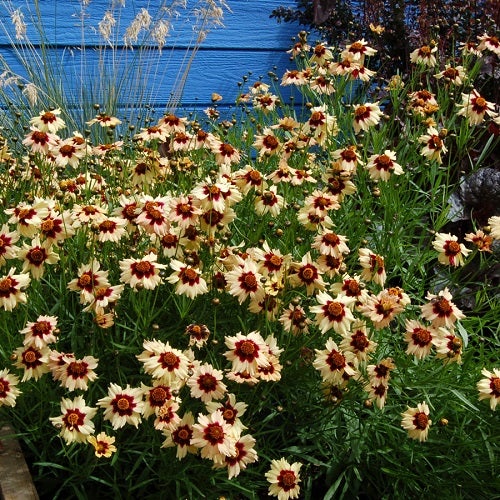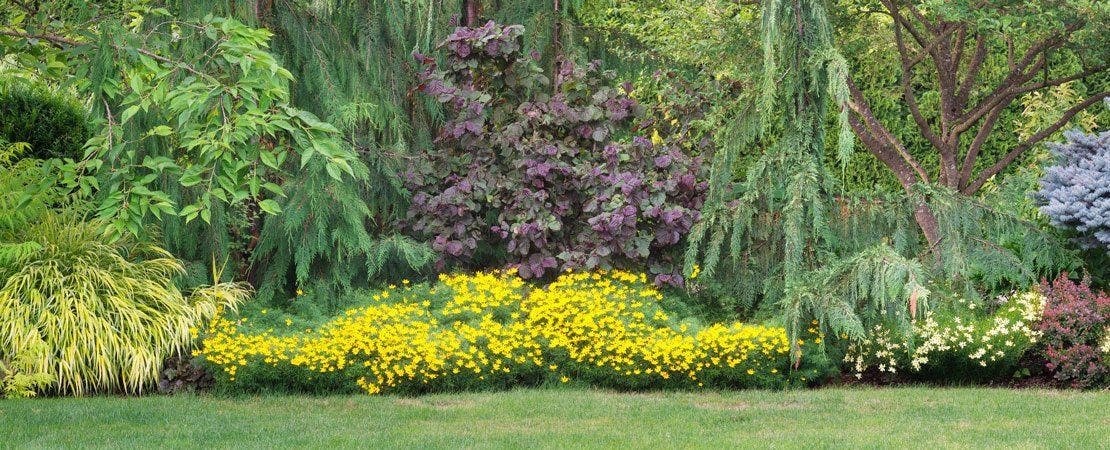Carefree, Colorful, Daisy-like Blooms of Coreopsis
Coreopsis are great plants. They are easy to grow, frost- and drought-tolerant. They grow only a few feet high and produce showy flowers all summer long. If you don’t have much space, or prefer your plants in pots, coreopsis grow well in containers. Not just a delight to the eye in the garden or pot, they make outstanding cut flowers. Coreopsis plants even produce a fine natural dye. Nifty natives, they are.


Names
Coreopsis is the scientific and common name of a group of attractive plants—bright daisy-like yellow or red or yellow-and-red flowers—in the daisy family, Asteraceae. Coreopsis is a mouthful, but its other common name is tickseed; surely coreopsis is a more dignified name. Tickseed describes the small dark seeds, which do look like ticks (tiny deer ticks, if you know your ticks). Actually, the word coreopsis means “like a bedbug” in Greek (korios bedbug, -opsis resembling). It’s the same idea as tickseed; the poor plant is stuck with having seeds that remind people of creepy pests. Growers offer nicer names; you can find coreopsis for sale as goldenwave, pot of gold, and calliopsis. The standard plural of coreopsis is coreopsises. Because coreopsis is the Latin name, it is also proper to make the plural Latin-style, coreopses (as in crisis, crises). But it ends in s, so I have always used “coreopsis” as both plural and singular; dictionaries recognize that, too. Take your pick.
Types of Coreopsis
There are 35 species of Coreopsis, 28 of them native to North America. Every state except Nevada and Utah has at least one native species. One or more varieties will flourish anywhere you live in the lower 48 states. Annual coreopsis flower abundantly and self-seed. Perennials form a clump that steadily enlarges.
Coreopsis grow in most soils, from dry to moist, clayey to sandy, but not wet soil; any soil needs to be well-drained. Their soil pH preference is 6.5 to 7, but they are not demanding. Most varieties are somewhat salt-tolerant. There are varieties for every garden, well-adapted to drought, the occasional flood, cold or heat.
The foliage is a rich green color, the leaves feathery or oval or lobed, depending on the species. Some varieties have variegated leaves. The leaves have a mild spicy scent I like. Dwarf varieties stand under a foot tall when blooming, most are about two feet tall, and the tallest coreopsis reach four feet.
The flowers range from about one inch across to hybrids with three-inch flowers. The coreopsis flower is really a flower head, also called an inflorescence, with a group of tiny flowers (florets) pressed together. There are two kinds of florets in a coreopsis flower head: the florets in the center, disc florets, lack petals and the outer ones, ray florets, each have one very big petal. Petal colors in coreopsis are diverse, from a variety of shades of yellow to white to pink to red and purple. The disc florets in the center can be the same shade as the ray florets around them, or contrasting, creating wonderful variety. In doubles, each ray floret makes big two petals going in the same direction. Look closely at a double sometime.
Coreopsis make excellent cut flowers, in fact they are grown commercially for cut flowers. The stiff stems can be a foot long and support numerous flower heads. After cutting, coreopsis flower heads can last two weeks; the secret is that the tiny florets keep opening and the head holds up looking nice until the last floret is through flowering.
Where to Plant Coreopsis
Coreopsis are recommended for borders, on slopes, and as a splash of color in a flowerbed. Species that naturalize will enhance a mixed planting with ornamental grasses. The shorter species make excellent ground covers. Or, for containers overflowing with color all summer long, grow coreopsis in pots.
Planting Coreopsis
Read the requirements of the plant before you choose it. Perennial coreopsis grow from USDA Zones 3-9, but individual plants may be more limited, for example Zones 3-6 for Coreopsis verticillate varieties. All coreopsis do well in full sun, and some tolerate partial shade.
The fastest way to have a fine stand of coreopsis is to buy them potted. For best success, wait to transplant until after the last frost. If they were grown indoors, or you aren’t sure how they were grown, harden them off. Start hardening off about two weeks before planting. Gradually expose the plants to outdoor conditions by putting them out in the shade, first for just a couple hours, gradually increasing the time the plants stay in full sun. By the last couple days before transplanting, they can stay out overnight. Watch the weather during hardening off; don’t put the plants outside in high winds or if temperatures drop below 45℉.
To plant, dig holes approximately 12-18” apart. Pay attention to the width expected of the variety you are planting and give the plants room to spread; mine produced patches several feet across in about five years. Dig a hole at least an inch in all directions larger than the container (up to twice its size). The idea is to have looser soil around the plant, so that the roots easily expand out from the root ball. Add compost or a small amount of a general fertilizer if your soil is poor, but these hardy natives will grow well in unamended soils. Remove the plant from the pot. Remember: the pot is less valuable than the plant. Once out of the pot, pull the bottom of root ball gently apart, loosening it. Fill the hole until the plant sits comfortably with the soil line from the pot sitting level with the soil line of your hole. Fill in with soil and pack down lightly but firmly. Water thoroughly.
You can also start coreopsis as seeds. Sow seeds indoors and transplant, or seed directly outdoors. To start the plants indoors, plant seeds 8-12 weeks before the last frost; these should flower the first year. Because light speeds up the germination of coreopsis seeds, cover them with just a bit of soil, or not at all. Keep them warm (about 70o F) and provide bright light. Transplant them outdoors after hardening off, after the threat of frost has passed. Keep them moist for several weeks.
If you are seeding directly, put seeds into a prepared bed in the early spring or after temperatures have cooled in the fall. Set seeds at least 2-3” apart, barely covered. In Zones 9 and 10, plant annuals outdoors in late fall, winter, or very early spring. Thin crowded seedlings when they are four inches tall. Water regularly for the first year.
Maintenance
Once established, coreopsis are very low maintenance. They thrive in some very poor or dry spots.
Cut off the old flowers (dead head) for better flower production. Most coreopsis plants produce a burst of bloom in early summer and continue flowering thereafter without management but will flower more if the old flower heads are removed.
The plants self-seed if they are flowering well. If you don’t want that, remove the old flower heads. Some hybrids are sterile or nearly, however. Be aware of that in selecting a coreopsis variety if you want seedlings. Annual species need to produce mature seeds and scatter them to reseed, so late in summer, stop dead heading. All species will keep their round, brown seed pods into the winter, adding visual interest.
Clumps of perennial coreopsis steadily expand. After three or so years, thinning is recommended. Clumps can be divided to have more coreopsis. The gardening books make digging up the clump, whether to reduce or transplant it, sound easy, but my plants’ roots were tough; transplanting worked fine, but the plants did not just lift off into my hands, I chopped and pulled. Leave new fall growth for protection overwintering.
Coreopsis have few problems. They can develop mildew and other fungal diseases in periods of high humidity. Get expert identification of diseases because most will not require treatment.
Coreopsis and Wildlife
Coreopsis’ bright flower heads attract a wide array of pollinators, from spectacular butterflies to bees to beetles, skippers, moths, wasps and more, varying by variety and location. They are native, so expect insects to chew on them. Coreopsis are host plants for several native moths including the handsome wavy-lined emerald (Synchlora aerate) and the dimorphic gray (Tornos scolopacinaria). Healthy plants will outgrow insect damage. Finches and other songbirds eat the seeds. The chemicals that produce the odor I like deter rabbits and deer, though if there is little else available, animals will eat coreopsis.
Dye Plants
Coreopsis leaves, flowers, and stems make excellent yellow or green dyes, depending on the dye bath conditions. The annual, plains coreopsis, Coreopsis tinctoria, is probably the best (tinctoria in its scientific name means “used in dyeing”), but I get excellent dyes from perennial coreopsis too.
Grow several of these lovely plants! Make bouquets, watch butterflies!






